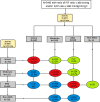P/FP ratio: incorporation of PEEP into the PaO2/FiO2 ratio for prognostication and classification of acute respiratory distress syndrome
- PMID: 34370116
- PMCID: PMC8350287
- DOI: 10.1186/s13613-021-00908-3
P/FP ratio: incorporation of PEEP into the PaO2/FiO2 ratio for prognostication and classification of acute respiratory distress syndrome
Abstract
Background: The current Berlin definition of acute respiratory distress syndrome (ARDS) uses the PaO2/FiO2 (P/F) ratio to classify severity. However, for the same P/F ratio, a patient on a higher positive end-expiratory pressure (PEEP) may have more severe lung injury than one on a lower PEEP.
Objectives: We designed a new formula, the P/FP ratio, incorporating PEEP into the P/F ratio and multiplying with a correction factor of 10 [(PaO2*10)/(FiO2*PEEP)], to evaluate if it better predicts hospital mortality compared to the P/F ratio post-intubation and to assess the resultant changes in severity classification of ARDS.
Methods: We categorized patients from a dataset of seven ARDS network trials using the thresholds of ≤ 100 (severe), 101-200 (moderate), and 201-300 (mild) for both P/F (mmHg) and P/FP (mmHg/cmH2O) ratios and evaluated hospital mortality using areas under the receiver operating characteristic curves (AUC).
Results: Out of 3,442 patients, 1,057 (30.7%) died. The AUC for mortality was higher for the P/FP ratio than the P/F ratio for PEEP levels > 5 cmH2O: 0.710 (95% CI 0.691-0.730) versus 0.659 (95% CI 0.637-0.681), P < 0.001. Improved AUC was seen with increasing PEEP levels; for PEEP ≥ 18 cmH2O: 0.963 (95% CI 0.947-0.978) versus 0.828 (95% CI 0.765-0.891), P < 0.001. When the P/FP ratio was used instead of the P/F ratio, 12.5% and 15% of patients with moderate and mild ARDS, respectively, were moved to more severe categories, while 13.9% and 33.6% of patients with severe and moderate ARDS, respectively, were moved to milder categories. The median PEEP and FiO2 were 14 cmH2O and 0.70 for patients reclassified to severe ARDS, and 5 cmH2O and 0.40 for patients reclassified to mild ARDS.
Conclusions: The multifactorial P/FP ratio has a greater predictive validity for hospital mortality in ARDS than the P/F ratio. Changes in severity classification with the P/FP ratio reflect both true illness severity and the applied PEEP strategy.
Trial registration: ClinialTrials.gov-NCT03946150.
Keywords: Acute respiratory distress syndrome; Mortality; PaO2/FiO2 ratio; Positive end-expiratory pressure.
© 2021. The Author(s).
Conflict of interest statement
The authors declare that they have no competing interest.
Figures



References
-
- Fan E, Del Sorbo L, Goligher EC, Hodgson CL, Munshi L, Walkey AJ, Adhikari NKJ, Amato MBP, Branson R, Brower RG, et al. An official American Thoracic Society/European Society of Intensive Care Medicine/Society of Critical Care Medicine clinical practice guideline: Mechanical ventilation in adult patients with acute respiratory distress syndrome. Am J Respir Crit Care Med. 2017;195(9):1253–1263. doi: 10.1164/rccm.201703-0548ST. - DOI - PubMed
-
- Bellani G, Laffey JG, Pham T, Fan E, Brochard L, Esteban A, Gattinoni L, van Haren F, Larsson A, McAuley DF, et al. Epidemiology, patterns of care, and mortality for patients with acute respiratory distress syndrome in intensive care units in 50 countries. JAMA. 2016;315(8):788–800. doi: 10.1001/jama.2016.0291. - DOI - PubMed
-
- Ranieri VM, Rubenfeld GD, Thompson BT, Ferguson ND, Caldwell E, Fan E, Camporota L, Slutsky AS. Acute respiratory distress syndrome: the Berlin Definition. JAMA. 2012;307(23):2526–2533. - PubMed
-
- Villar J, Perez-Mendez L, Lopez J, Belda J, Blanco J, Saralegui I, Suarez-Sipmann F, Lopez J, Lubillo S, Kacmarek RM, et al. An early PEEP/FIO2 trial identifies different degrees of lung injury in patients with acute respiratory distress syndrome. Am J Respir Crit Care Med. 2007;176(8):795–804. doi: 10.1164/rccm.200610-1534OC. - DOI - PubMed
-
- Villar J, Perez-Mendez L, Blanco J, Anon JM, Blanch L, Belda J, Santos-Bouza A, Fernandez RL, Kacmarek RM, Spanish Initiative for Epidemiology et al. A universal definition of ARDS: the PaO2/FiO2 ratio under a standard ventilatory setting–a prospective, multicenter validation study. Intensive Care Med. 2013;39(4):583–592. doi: 10.1007/s00134-012-2803-x. - DOI - PubMed
Associated data
LinkOut - more resources
Full Text Sources
Medical

